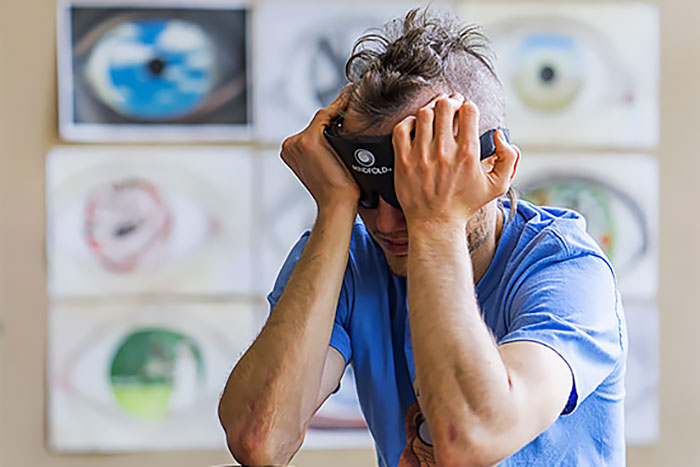A valuable training technique
On the surface the blindfold chess feature in Fritz 16 could be dismissed as just a curiosity, or as a function that is beyond your current skillset. Whatever the case, this would be a serious mistake, since used properly it could become one of your key training tools, even if you can barely play a few moves without seeing before you get lost. In fact, especially if that is the case!
When you play a game, you quickly face one of the hardest tasks: seeing ahead. More than just choosing moves, we must strive to calculate them and their consequences as best we can. In a plain king and pawn endgame, the task is quite feasible since you only need to keep track of those pieces, but if you face a full board it is quite another matter.
Practicing blindfold chess can be a great way to handle this, and not only does Fritz 16 provide tools for this, but it also gives you assists like quick glances of the board, and more. Let’s take a look at it.
Easy Game
The first thing to do is start a game with the Easy Game feature on the opening screen. The procedure here is straightforward and is described in the previous tutorial on this topic.

You can choose the level of opposition, all especially designed to be accessible and fun opponents, so don’t be afraid. Since this is blindfold, even with cheats, best to play one level easier than you would normally choose.
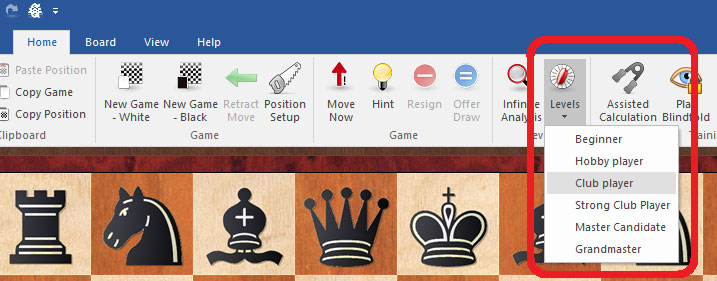
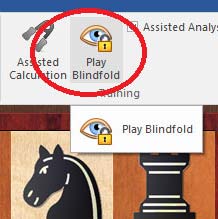
Initially you have your normal full board, and visible. Feel free to take it in, study it, ready yourself, and then press the Play Blindfold button.
Bingo, the pieces have all disappeared! To play, you will do as you normally do: that is to click on the square of the piece you want to play, and then ‘drag’ it to the destination square. In this case I have chosen 1.e4. The board remains blank, but the notation on the side now shows my move and Fritz’s reply: 1…c6. To help, though this really is minor, there is an arrow indicating its last move.
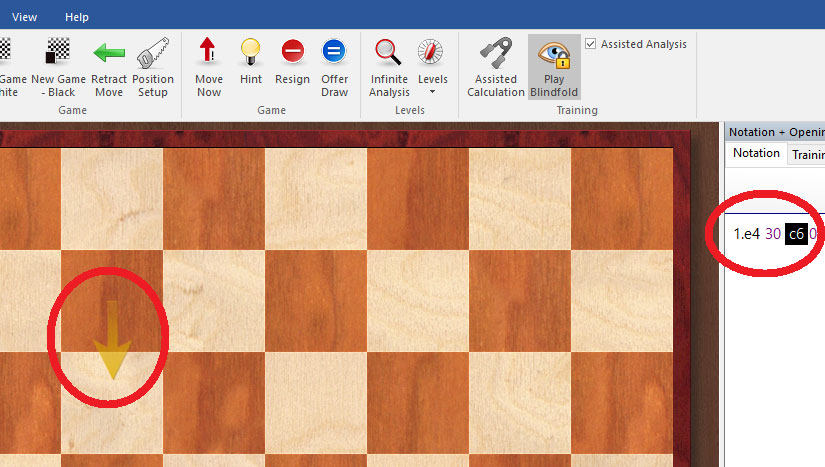
Let’s play a few more moves, all without any help. After about seven moves, we have played 1.e4 c6 (a Caro-Kann) 2.d4 d5 3.exd5 cxd5 4.c4 Nf6 5.Nc3 Nc6 6.Nf3 Bg4 7.cxd5 Nxd5. Suddenly I am a bit in doubt. Should I play my bishop, or perhaps my c-pawn before. My image of the board in my mind is ok I think, but I’m not sure. Time to look at the board.
Removing the blindfold
What? Look at the board? Isn’t that cheating? The answer is a clear cut ‘yes and no’. If you really wanted to play the entire game now entirely blind, then yes, this is a cheat, and one can argue that this is the unquestioning goal of this training. Absolutely. However, before you can start running marathons, it is a good idea to start with shorter distances within your reach. In this case, we can establish that every 5-7 moves, or whatever you are comfortable with, you will ‘remove the blindfold’ by pressing the Play Blindfold button again, reacquaint yourself with the position, and then put the blindfold back on by pressing the button.
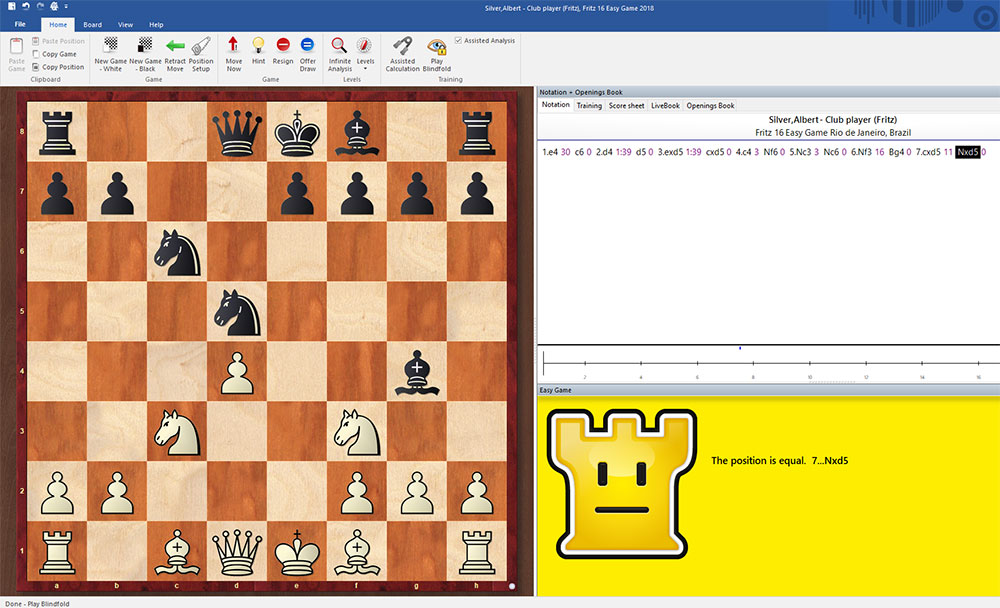
Only now do we make our move, preserving at least the spirit of ‘playing’ all the moves without seeing them. A subtle nicety, but an important one.
Asking for help
This is not the only way to get a bit of assistance though. You may recall a nice feature in Easy Game mode, in which you can get a ‘hot or cold’ hint from Fritz 16 by simply clicking on a piece and waiting a couple of seconds. Squares will light up with Green meaning that is a good choice, and red meaning a bad move. This feature works in blindfold mode as well, even with the pieces still invisible.

By default this Assisted Analysis is off, and if it is, just turn it on by activating it. Now, with the board still blank, I could ‘grab’ my bishop on f1 and hold it for Fritz 16’s opinion. If it shows all red squares or no green ones, I know that the bishop is probably not my best piece choice here. As it is, Bc4 is a good move, possibly the best.
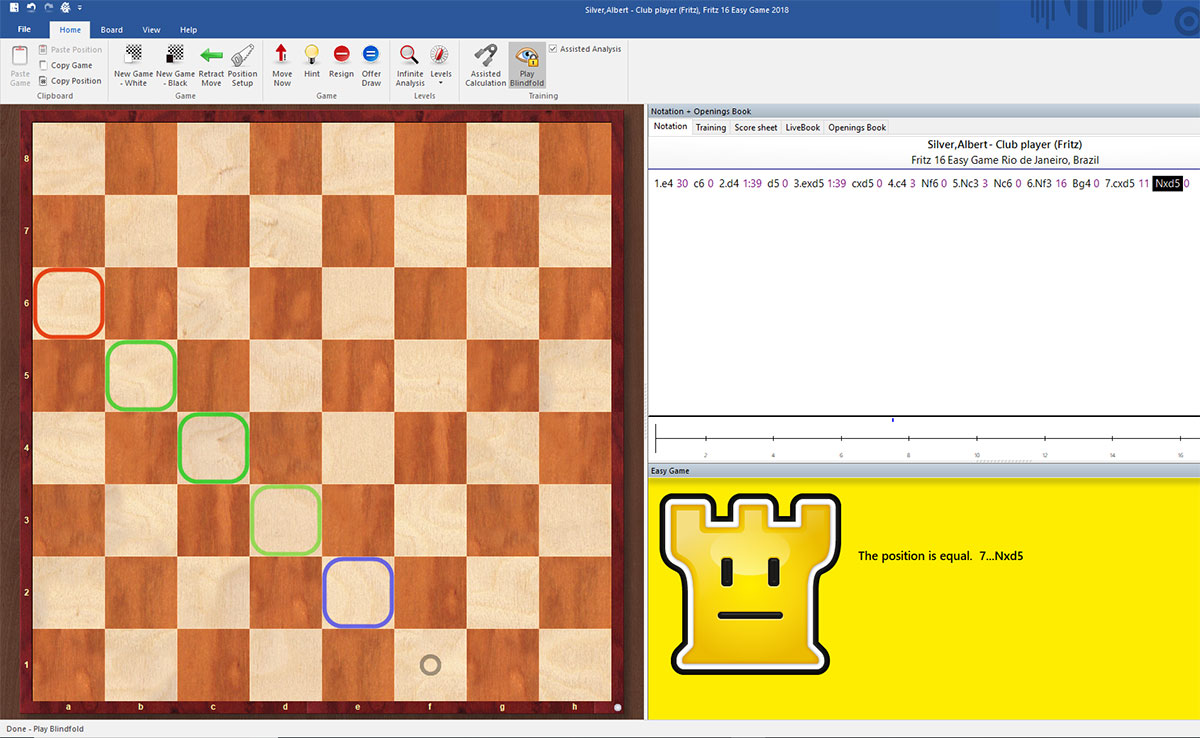
Remember that this is not the engine running on all cores, full strength. These tips are a crutch, but nothing more. If you want full analysis by the engine there are better ways to go about it.
How to maximize training
The secret is to set clear goals and parameters. You want to training, and you want that training to be productive. Let’s suppose you don’t want to work with more than five moves without refresh of what the board looks like.
You would therefore reveal the board on moves 5, 10, 15, etc. If this seems too easy, remember that there is more going on here than just following five moves without seeing: you also need to do your own calculations on the moves before to be sure you are not dropping a piece.
You might also establish you will allow yourself only one Assisted Analysis per block of five moves. You could say all moves are game, or not. If not, then be sure to turn Assisted Analysis on when you want to use it, and off when you are done.
If this limit of X moves becomes easy, by all means increase the number of moves played unseen. Again, the goal here is controlled increase of the difficulty to help you improve, and if you use this tool intelligently, using the method above, or another of your devising, you can be sure your standard of play will improve.
Fritz 16 is looking forward to playing with you, and you're certain to have a great deal of fun with him too. Tense games and even well-fought victories await you with "Easy play" and "Assisted analysis" modes.
Links
